Answered step by step
Verified Expert Solution
Question
1 Approved Answer
Evaluating cash flows with the NPV method The net present value (NPV) rule is considered one of the most common and preferred criteria that generally
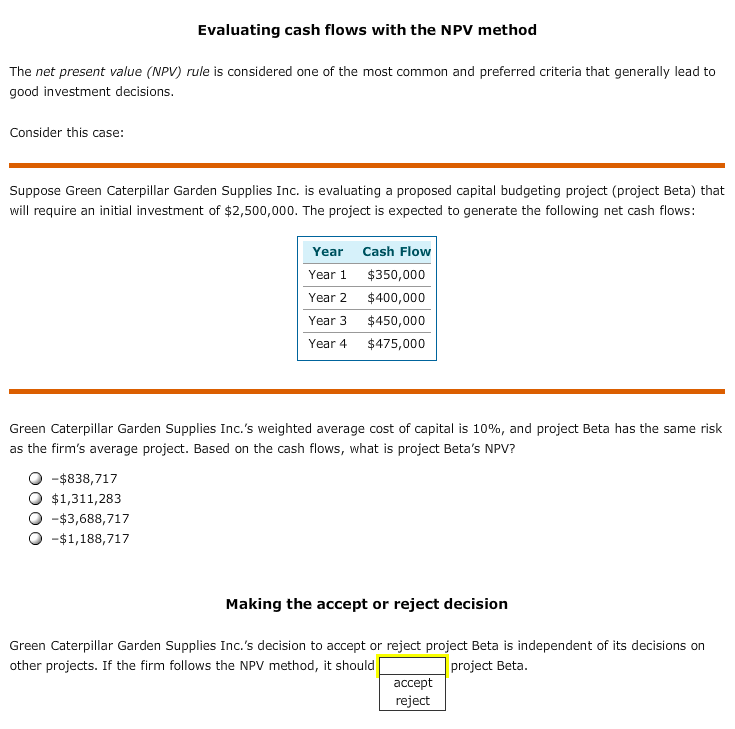
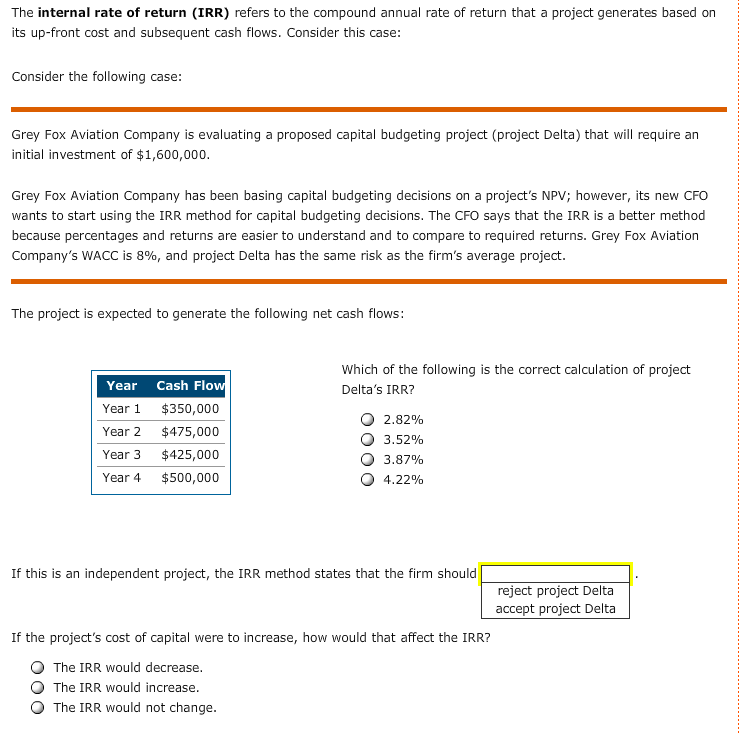
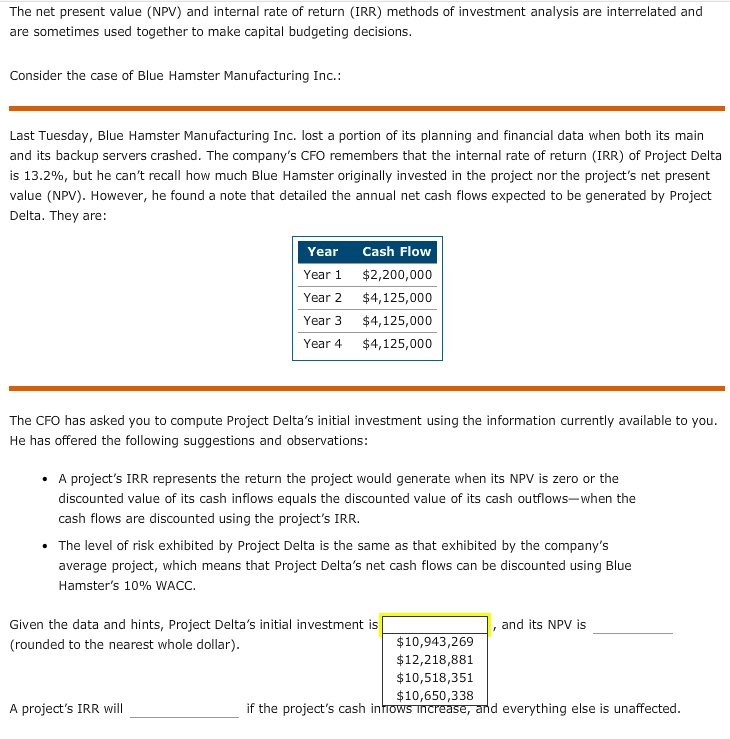
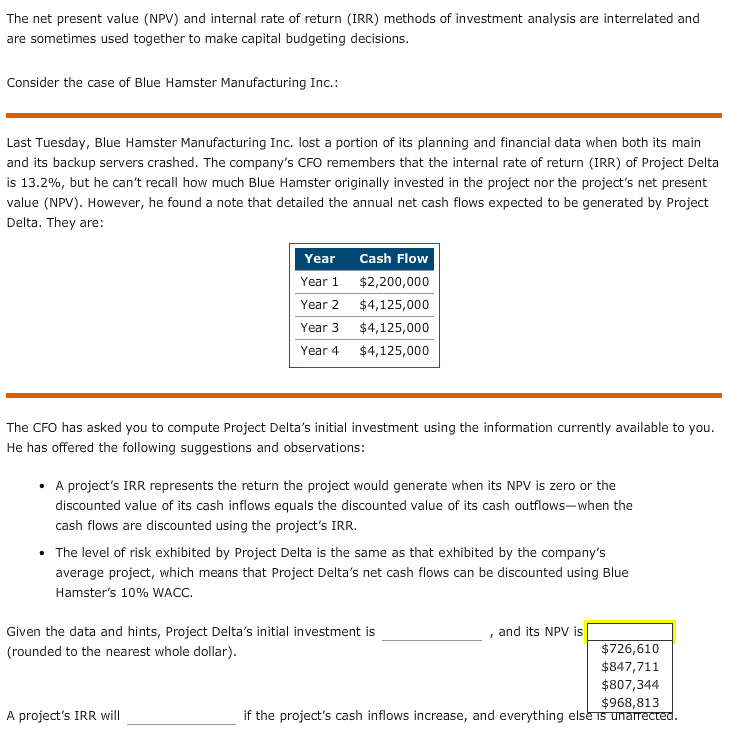
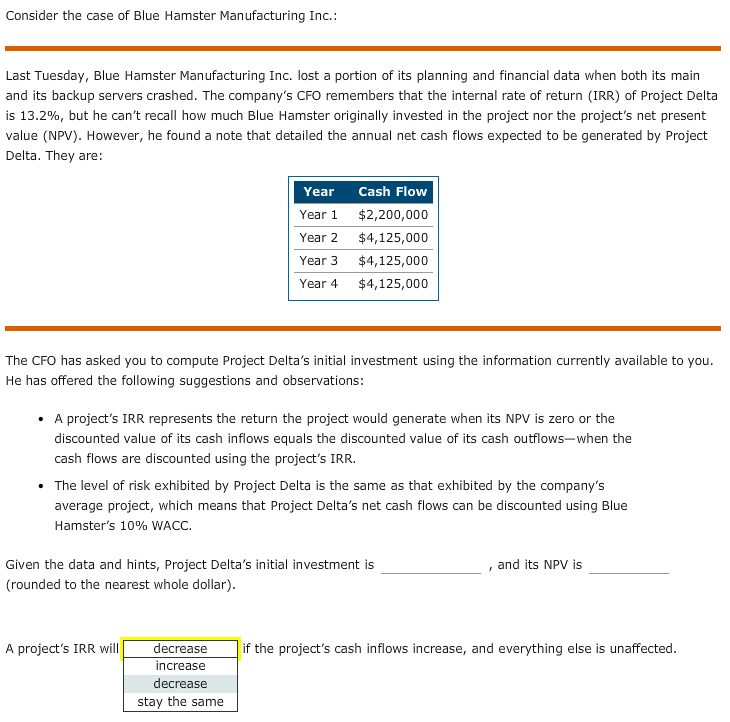
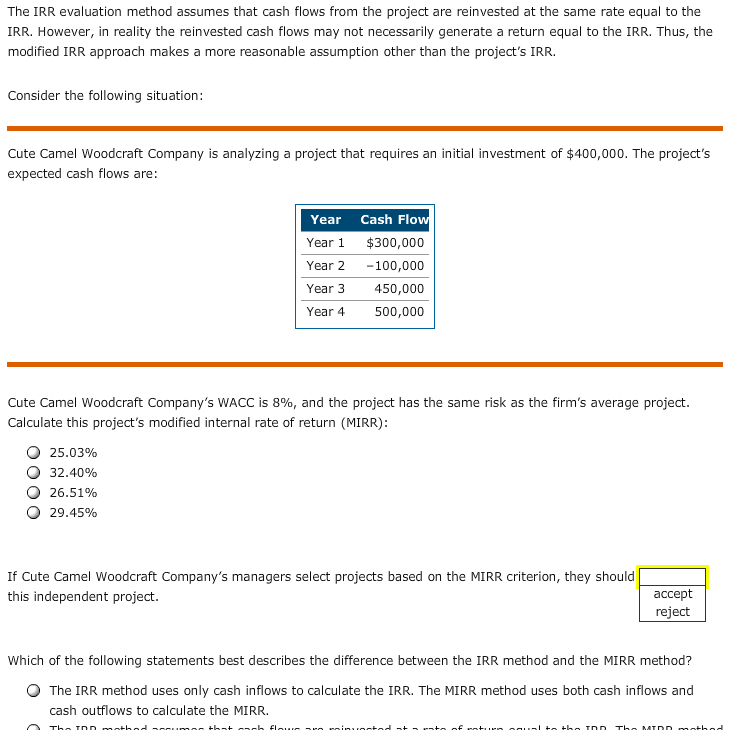
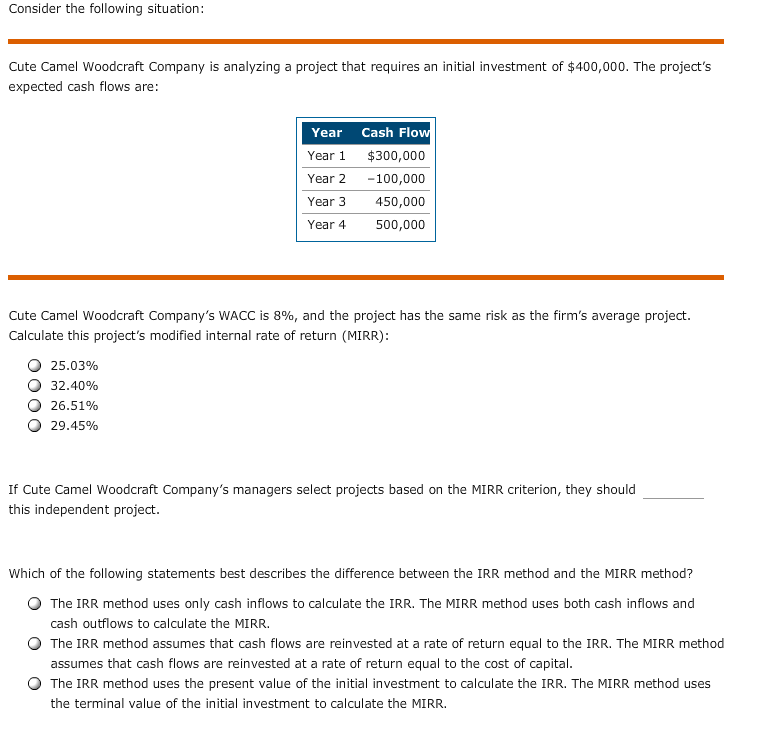
Evaluating cash flows with the NPV method The net present value (NPV) rule is considered one of the most common and preferred criteria that generally lead to good investment decisions. Consider this case: Suppose Green Caterpillar Garden Supplies Inc. is evaluating a proposed capital budgeting project (project Beta) that will require an initial investment of $2,500,000. The project is expected to generate the following net cash flows: Year Year 1 Year 2 Cash Flow $350,000 $400,000 $450,000 $475,000 Year 3 Year 4 Green Caterpillar Garden Supplies Inc.'s weighted average cost of capital is 10%, and project Beta has the same risk as the firm's average project. Based on the cash flows, what is project Beta's NPV? -$838,717 $1,311,283 -$3,688,717 -$1,188,717 Making the accept or reject decision Green Caterpillar Garden Supplies Inc.'s decision to accept or reject project Beta is independent of its decisions on other projects. If the firm follows the NPV method, it should project Beta. accept reject The internal rate of return (IRR) refers to the compound annual rate of return that a project generates based on its up-front cost and subsequent cash flows. Consider this case: Consider the following case: Grey Fox Aviation Company is evaluating a proposed capital budgeting project (project Delta) that will require an initial investment of $1,600,000. Grey Fox Aviation Company has been basing capital budgeting decisions on a project's NPV; however, its new CFO wants to start using the IRR method for capital budgeting decisions. The CFO says that the IRR is a better method because percentages and returns are easier to understand and to compare to required returns. Grey Fox Aviation Company's WACC is 8%, and project Delta has the same risk as the firm's average project. The project is expected to generate the following net cash flows: Which of the following is the correct calculation of project Delta's IRR? Year Year 1 Year 2 Cash Flow $350,000 $475,000 $425,000 $500,000 Year 3 2.82% 3.52% 3.87% 4.22% Year 4 If this is an independent project, the IRR method states that the firm should reject project Delta accept project Delta If the project's cost of capital were to increase, how would that affect the IRR? The IRR would decrease. The IRR would increase. The IRR would not change. The net present value (NPV) and internal rate of return (IRR) methods of investment analysis are interrelated and are sometimes used together to make capital budgeting decisions. Consider the case of Blue Hamster Manufacturing Inc.: Last Tuesday, Blue Hamster Manufacturing Inc. lost a portion of its planning and financial data when both its main and its backup servers crashed. The company's CFO remembers that the internal rate of return (IRR) of Project Delta is 13.2%, but he can't recall how much Blue Hamster originally invested in the project nor the project's net present value (NPV). However, he found a note that detailed the annual net cash flows expected to be generated by Project Delta. They are: Year Year 1 Year 2 Cash Flow $2,200,000 $4,125,000 $4,125,000 $4,125,000 Year 3 Year 4 The CFO has asked you to compute Project Delta's initial investment using the information currently available to you. He has offered the following suggestions and observations: A project's IRR represents the return the project would generate when its NPV is zero or the discounted value of its cash inflows equals the discounted value of its cash outflows-when the cash flows are discounted using the project's IRR. The level of risk exhibited by Project Delta is the same as that exhibited by the company's average project, which means that Project Delta's net cash flows can be discounted using Blue Hamster's 10% WACC. Given the data and hints, Project Delta's initial investment is and its NPV is (rounded to the nearest whole dollar). $10,943,269 $12,218,881 $10,518,351 $10,650,338 A project's IRR will if the project's cash introws increase, and everything else is unaffected. The net present value (NPV) and internal rate of return (IRR) methods of investment analysis are interrelated and are sometimes used together to make capital budgeting decisions. Consider the case of Blue Hamster Manufacturing Inc.: Last Tuesday, Blue Hamster Manufacturing Inc. lost a portion of its planning and financial data when both its main and its backup servers crashed. The company's CFO remembers that the internal rate of return (IRR) of Project Delta is 13.2%, but he can't recall how much Blue Hamster originally invested in the project nor the project's net present value (NPV). However, he found a note that detailed the annual net cash flows expected to be generated by Project Delta. They are: Year Year 1 Year 2 Year 3 Cash Flow $2,200,000 $4, 125,000 $4,125,000 $4,125,000 Year 4 The CFO has asked you to compute Project Delta's initial investment using the information currently available to you. He has offered the following suggestions and observations: A project's IRR represents the return the project would generate when its NPV is zero or the discounted value of its cash inflows equals the discounted value of its cash outflows-when the cash flows are discounted using the project's IRR. The level of risk exhibited by Project Delta is the same as that exhibited by the company's average project, which means that Project Delta's net cash flows can be discounted using Blue Hamster's 10% WACC. Given the data and hints, Project Delta's initial investment is and its NPV is (rounded to the nearest whole dollar). $726,610 $847,711 $807,344 $968,813 A project's IRR will if the project's cash inflows increase, and everything else is unarrected. Consider the case of Blue Hamster Manufacturing Inc.: Last Tuesday, Blue Hamster Manufacturing Inc. lost a portion of its planning and financial data when both its main and its backup servers crashed. The company's CFO remembers that the internal rate of return (IRR) of Project Delta is 13.2%, but he can't recall how much Blue Hamster originally invested in the project nor the project's net present value (NPV). However, he found a note that detailed the annual net cash flows expected to be generated by Project Delta. They are: Year Year 1 Year 2 Cash Flow $2,200,000 $4,125,000 $4, 125,000 $4,125,000 Year 3 Year 4 The CFO has asked you to compute Project Delta's initial investment using the information currently available to you. He has offered the following suggestions and observations: A project's IRR represents the return the project would generate when its NPV is zero or the discounted value of its cash inflows equals the discounted value of its cash outflows-when the cash flows are discounted using the project's IRR. The level of risk exhibited by Project Delta is the same as that exhibited by the company's average project, which means that Project Delta's net cash flows can be discounted using Blue Hamster's 10% WACC. and its NPV is Given the data and hints, Project Delta's initial investment is (rounded to the nearest whole dollar). A project's IRR will if the project's cash inflows increase, and everything else is unaffected. decrease increase decrease stay the same The IRR evaluation method assumes that cash flows from the project are reinvested at the same rate equal to the IRR. However, in reality the reinvested cash flows may not necessarily generate a return equal to the IRR. Thus, the modified IRR approach makes a more reasonable assumption other than the project's IRR. Consider the following situation: Cute Camel Woodcraft Company is analyzing a project that requires an initial investment of $400,000. The project's expected cash flows are: Year Cash Flow Year 1 $300,000 Year 2 -100,000 Year 3 450,000 Year 4 500,000 Cute Camel Woodcraft Company's WACC is 8%, and the project has the same risk as the firm's average project. Calculate this project's modified internal rate of return (MIRR): 25.03% 32.40% 26.51% 29.45% If Cute Camel Woodcraft Company's managers select projects based on the MIRR criterion, they should this independent project. accept reject Which of the following statements best describes the difference between the IRR method and the MIRR method? The IRR method uses only cash inflows to calculate the IRR. The MIRR method uses both cash inflows and cash outflows to calculate the MIRR. TTDD web Flu TO TOMADDE Consider the following situation: Cute Camel Woodcraft Company is analyzing a project that requires an initial investment of $400,000. The project's expected cash flows are: Year Cash Flow Year 1 $300,000 Year 2 -100,000 Year 3 450,000 Year 4 500,000 Cute Camel Woodcraft Company's WACC is 8%, and the project has the same risk as the firm's average project. Calculate this project's modified internal rate of return (MIRR): 25.03% 32.40% 26.51% 29.45% If Cute Camel Woodcraft Company's managers select projects based on the MIRR criterion, they should this independent project. Which of the following statements best describes the difference between the IRR method and the MIRR method? The IRR method uses only cash inflows to calculate the IRR. The MIRR method uses both cash inflows and cash outflows to calculate the MIRR. The IRR method assumes that cash flows are reinvested at a rate of return equal to the IRR. The MIRR nethod assumes that cash flows are reinvested at a rate of return equal to the cost of capital. The IRR method uses the present value of the initial investment to calculate the IRR. The MIRR method uses the terminal value of the initial investment to calculate the MIRR
Step by Step Solution
There are 3 Steps involved in it
Step: 1

Get Instant Access to Expert-Tailored Solutions
See step-by-step solutions with expert insights and AI powered tools for academic success
Step: 2

Step: 3

Ace Your Homework with AI
Get the answers you need in no time with our AI-driven, step-by-step assistance
Get Started


